Home
A comprehensive resource for safe and responsible laser use

What are laser pointers and handheld lasers good for?
A note from the website’s author: The essay below represents my personal thoughts. This page is less fact-based, and more philosophical/opinionated, than most of the other material here at LaserPointerSafety.com.
A number of reporters have asked me “What use are laser pointers?” Certainly there are some useful consumer applications: presentations, star gazing with others (e.g., Boy Scouts or school trips), and playing with pets. In a wilderness emergency, a laser pointer can be more effective than a flashlight in signaling searchers. Pointers also have a place in the classroom, to teach light and physics properties.
A December 2011 news story described how a home care nurse used laser pointers purchased at Office Depot to enable patients to communicate. The pointers are attached to eyeglass frames or a cap. They allow patients with limited mobility to point out letters and words on a communication board.
In October 2014, a reader named Brian Palmer wrote to describe how a high-powered laser can be used to remove unwanted growths in aquariums, including aiptasia (shown below), green star polyps, xenia, mojano, valonia and cyano. He does note that it is necessary to take precautions to avoid laser light reflecting off the glass surfaces, including using laser safety glasses during the procedure. A discussion on Reef Central is here; a similar discussion is at Reef2Reef.

Unwanted aiptasia polyp on a coral

A 700 mW, 445 nanometer Wicked Laser Spyder Arctic heats it up and destroys it in 10 seconds. A video is here.
The aiptasia will not grow back.
The website Hackaday.com has a number of laser hacking projects, many of which require powers over 5 milliwatts.
Why do people buy high-powered lasers?
Most consumer uses -- other than killing aquarium growths -- don’t need more than 5 milliwatts (the traditional U.S. maximum for lasers sold as pointers). So why do some people buy handheld lasers that are 25, 100, 250 or even 1000 milliwatts?
One reason is that there are laser enthusiasts who enjoy experimenting with lasers. They can create homemade laser light shows, they can do experiments involving burning or engraving materials, or they may like popping balloons or popcorn kernels with light. A New York Times article quotes an 18-year-old enthusiast as saying, “You learn so much in a hobby like this: electronics, soldering, physics. And you learn about light, you learn about optics. You also learn a lot of mechanical things.”
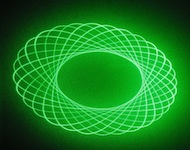
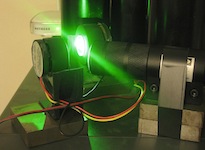
A homemade light show. The simple apparatus -- two motors each with a mirror attached -- is shown on the right. Photos by Pat Joyce (“phatcontroller”) from Flickr, cc by-nc 2.0 license.
This is similar to car enthusiasts who like to supercharge their engines, or add racing-style spoilers and body panels. It is also similar to computer enthusiasts who overclock their systems with water-cooling, or who make custom case modifications. None of these hobbies is "good for" anything specifically, but they also aren't harmful hobbies.
In addition, there are people who simply like to see the laser beam. A 5 mW beam is very weak. Laser fans tend to want the most visible, most powerful beam they can afford. Perhaps they like Star Wars or Star Trek, and so they enjoy having their own working “lightsaber” or “phaser”.

One enthusiast pastime is shining the laser through various materials to see the beam or the resulting light pattern. Photo of a laser through a glass of water by Stéphane Magnenat from Flickr, cc by-sa 2.0 license.
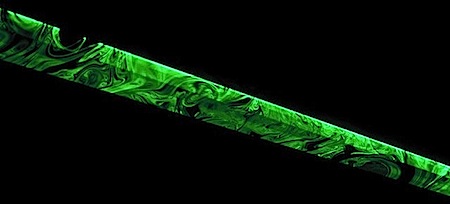
A laser beam moved in a line intersects a thin plane of smoke, making beautiful swirling patterns. This “sword of laser smoke” image is by dawgfanjeff from Flickr, cc by-nc-nd 2.0 license.
A powerful beam also makes it possible to see brighter laser lumia. This is a term for the nebula-like patterns created when laser light goes through, or bounces off, a material such as textured glass or plastic.
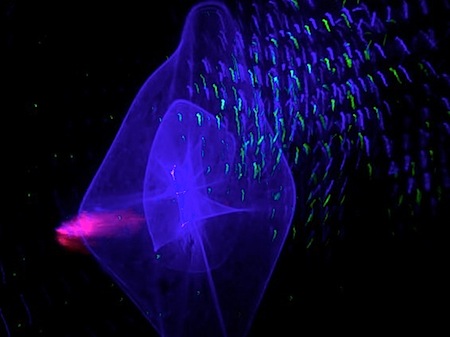
Laser lumia effects created by Tim Walsh, Laser Spectacles Inc. The more powerful the laser, the brighter and more detailed the lumia. Photo by laserbub from Flickr, cc by-nc 2.0 license.
Finally, wanting a powerful laser may be human nature -- especially male human nature. Laser enthusiasts are generally male; perhaps they simply want a bigger, better gadget than the guy next door.
Laser hobbyists may have parallels with computer hobbyists
It is possible that access to high-powered, low-cost lasers may trigger new uses for lasers. Think about these parallels between computers and lasers:
- The PC revolution: In the 1950’s and 1960’s, computers were large, expensive, and relatively rare devices, tended by experts. Then in the 1970’s came the microprocessor. This small and inexpensive device was taken up by hobbyists and enthusiasts at places like the legendary Homebrew Computer Club. Their first machines were underpowered and difficult to use, but they rapidly improved. It was these hobbyists who triggered the PC revolution.
- A possible laser pointer revolution?: In the last century, visible lasers with substantial beam powers were large, expensive and relatively rare devices, tended by experts. Then in the mid-2000’s came affordable laser pointers and diode lasers. These small and inexpensive devices have been taken up by hobbyists and enthusiasts on Internet forums such as LaserPointerForums.com (20,500 members with 674,000 posts) and PhotonLexicon.com (4500 members with 190,000 posts). Enthusiasts are developing applications and demonstrations in areas such as laser pointer microscopy, inexpensive 3D scanners, quantum erasure, advanced optics and photography timing sensors like this and this. Michigan State University developed a system using a laser similar to a pointer, to detect explosive materials for the Department of Homeland Security.
Not to stretch the parallels too far, but it is interesting that some early microcomputer pioneers started with less-than-legal activities. Steve Wozniak, Steve Jobs and John Draper built and used “blue boxes” to access free long-distance phone calls.
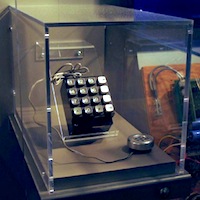
Illegal “blue box” built by Steve Wozniak, co-founder of Apple Computer. Now on display at the Computer History Museum.
Do lasers have to have a use?
When people ask “Why do consumers need high-powered lasers?”, this presupposes that lasers need to be useful in order to be permitted by society. However, this is not how most Western societies work.
Consider jewelry, which is perhaps the female equivalent of males liking high-powered pointers. Jewelry isn’t "good for anything”, meaning that no one really needs jewelry. Once a person has a reasonable-sized ring, there's no rational reason to move up to an expensive oversized rock. (Although this argument has not worked on my wife...)
Gold and diamond mining kills more people than have had laser pointer retinal damage
A laser safety expert once said to me, “But diamonds are not hazardous.” She was partially correct. While diamonds are not intrinsically hazardous, diamond mining is definitely dangerous.
In South Africa alone, an average of 11 diamond workers per year die in the mines.* Also, “conflict” or “blood” diamonds have supported civil wars in Angola, Liberia and other African countries. For example, Angolan rebels raised USD $3,700,000,000 from the sale of conflict diamonds -- not illegal at the time -- to finance their war with the government from 1992 to 1998.**
To give another example, diamonds are often set in gold. NBC reports that Mali, Africa’s third largest gold producer, exploits 20,000 to 40,000 child laborers in gold mines who are exposed to dangerous mercury and are paid in bags of dirt.
So it is not as simple as saying “product X is dangerous” or “product Y is not hazardous”.

Useless? Excessive? Supporting wars? Exploiting children? These attributes are in the eye of the beholder.
Is it OK to buy a pet rock or other “useless” product?
In most countries, people do not have to justify to the government why they want a legal product. Whether it is a pet rock or a 10-carat diamond or a 100 mW handheld laser, a person can buy it if they have the money. It doesn't matter whether the person uses it for work, uses it for pleasure, or puts it in a drawer after looking at it for ten minutes.
Of course, the person must use the product responsibly. And, there are some products which are so inherently dangerous that they do have to be restricted or banned in some way.
An analogy with knives and blades
Consider knives and blades. These are commonplace; there are probably dozens in any American household. Most people use them safely, but there are over 2 million U.S. emergency room visits each year from accidents, and over 75,000 visits annually from intentionally-caused injuries.*** Unlike lasers, knives are used to kill: 1,825 people in the U.S. were murdered with knives in 2009.****
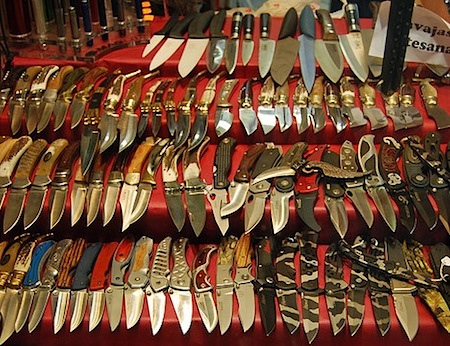
Knives for sale to consumers in a Barcelona shop. Photo by Ryan McDonald from Flickr, cc by 2.0 license.
Some categories of blades are considered so dangerous that there are restrictions; for example, switchblades and working (non-replica) swords. Yet, despite some serious problem areas, society deems the obvious benefits of knives to outweigh the injuries and deaths caused by misuse. (See this FAQ for more information comparing knife misuse with laser misuse.)
Now consider consumer lasers. Millions of pointers have been sold. In general, they have a very low misuse rate -- excepting of course aviation; see below. In terms of eye injuries, there are very few cases reported and only a handful of these each year are serious or permanent.
Some categories or powers of lasers are so dangerous that a consumer ban or restrictions might be justified. My personal opinion is that most consumers should not purchase handheld Class 4 lasers, which are so powerful that they can cause instant eye damage and can burn skin. (Although it is interesting that as of Feb. 2011, there has been only one minor report of temporary injury from a consumer-grade Class 4 laser.)
The primary problem with a ban or restrictions is with effective enforcement. Already, the federal laser safety agency FDA/CDRH is underbudgeted. It is difficult for them to stop illegal products from being imported or sold. Even with increased funding -- hard to come by in a time of federal budget cuts -- it would be tricky to come up with procedures that effectively restrict consumers, without significantly impeding industrial and research laser users. For this reason, many laser safety experts do not feel that a ban or restrictions are practical at this time. (See this FAQ for more information about a ban or restrictions.)
Aviation: By far the most serious problem
The main problem with pointers and handheld lasers, of course, is when ignorant or uncaring persons aim them at aircraft. Unfortunately, this is a serious problem requiring action.
As outlined elsewhere on this website, various groups need to help reduce the numbers and severity of incidents. These actions include user education, stepped up enforcement, and pilot training.
If a concerted effort does not bring down the number of incidents, then it may be necessary to have a ban or restrictions on laser pointers. Before doing so, studies should be done to see if bans or restrictions have been effective in areas such as New South Wales. Also, the legal language needs to be carefully written, to ensure it is effective without impairing legitimate uses. (For more information, see the page “If you are writing a laser law”.)
Notes
* South Africa Chamber of Mines, Facts & Figures 2010, page 10. Total diamond mining deaths, 2000-2009 is 112, or 11.2 per year.
** Wikipedia article, “Blood diamond”, retrieved March 24 2011. See also “Angolan Civil War”; total deaths during the 27 years of the war are estimated at 500,000 although figures are not given for deaths during the blood diamond selling period 1992-1998.
*** National Health Statistics Reports, 2007 Emergency Department Summary, table 13.
**** FBI Crime in the United States, Expanded Homicide Data Table 8, Murder Victims by Weapon, 2005-2009.